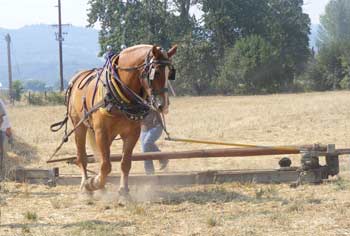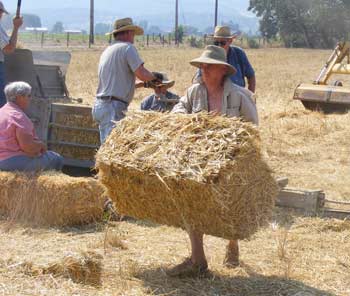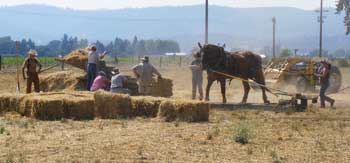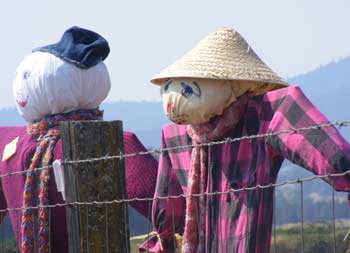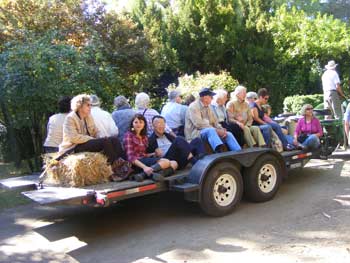What a thrill it was to watch the Hanley team thresh the wheat! Our next task was to press and bale the hay. The straw press Hanley Farm uses to complete this task dates back to the late 1880s, possibly early 1900s. John Casad, of the Hanley Historical Farming Committee, told me the press was rebuilt in 2000 and was originally stored at Givens Ranch. The Farming Committee received permission from the County, who owns the press, to store it at Hanley Farm, thus making it available for public use. The small, box-type presses were once powered by teams of horses walking in a circle, pulling the sweep-arm drive used to power the belt that pushes the plunger into the unit. In this case, one horse, Kimber South’s Belgian, Rex, provided the “horse power” required to operate our press. The hay is first hauled to the press and forked in the bale chamber by hand. The belt-driven drive pushes a plunger into the baler, compressing the hay. Once the bale reaches the right size, wooden blocks are dropped into the chamber, and wire or twine is manually threaded and tied around the bale. These early hay presses did make a significant difference in the amount of labor needed to bale the hay, but it still took plenty of workers to operate the press and to tend to the horses providing the power!
Operating our press required at least one person to tend the horse, several workers to fork the hay into the bale chamber, a couple more to place the wooden blocks, four people to manually thread the wire, and another one or two to stack the finished bale, weighing 200 pounds or more!
Have you noticed the scarecrows lining the fence at Hanley Farm? Participants in our September scarecrow-making workshop, held the same day we pressed the straw, made those scarecrows. Later, on October 15, we celebrated our Scarecrow Festival, where even more scarecrows were created! That was definitely fun. Have you wondered about scarecrows, where they come from, who created them?
I learned that scarecrows could be traced back 2500 years! Legend has it that the Greeks made a wooden scarecrow, carved to look like Priapus, the son of the goddess Aphrodite. Even though he was the son of a goddess, he was apparently very ugly! In fact, when he played in the vineyards, the vineyard keepers noticed that the birds did not bother their crops. So they made statues that looked like Priapus, and painted them purple and put a club in one hand, and a sickle in the other, to enhance his dangerous appearance!
In 1600, European settlers began to settle in North America and brought with them the use of human “bird-scarers” to guard their crops. The “scarers” might howl and shout if crows came near the crop, or perhaps throw stones to scare them away. Eventually, during the 1800s, German farmers built a human-looking scarecrow called “bootzamon,” or bogeyman. These creations resemble our modern day “bogeymen” in use to protect our crops today!
Have a wonderful Thanksgiving! And we invite you join in the Christmas festivities we have planned for you at the farm. Warm cider, good friends, and happy times await you.
For more information about Hanley Farm or upcoming events, call us at 541-773-2675; e-mail us at hanleyfarm@sohs.org; visit us on-line at www.sohs.org/properties/hanley-farm; or check out our Hanley Farm Facebook page!
Hanley Farm, owned and operated by the Southern Oregon Historical Society, is located at 1053 Hanley Road, between Jacksonville and Central Point.
